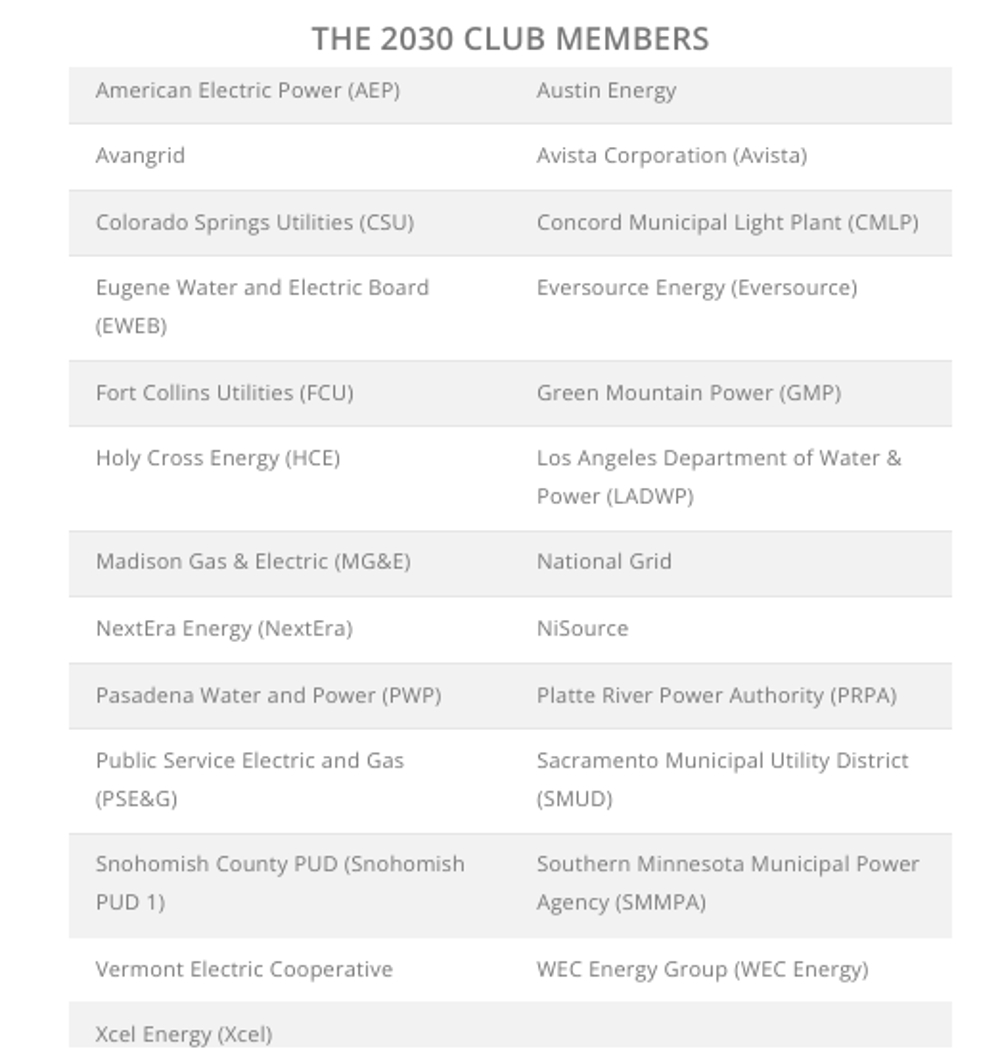Sign up for daily news updates from CleanTechnica on email. Or follow us on Google News!
During the Obama administration, the utility industry went berserk when the government came up with the Clean Power Plan — an effort to get those who generate America’s electricity to lower the carbon intensity of their operations. Some cynical politicians coined the idea of a “war on coal” and used it to promote their campaigns. But now, 25 investor-owned and municipal utility companies — including some of America’s largest electricity suppliers — have banded together to form the Smart Electric Power Alliance, an organization whose members pledge to cut their carbon emissions by 80% compared to 2005 levels no later than 2030.
Smart Electric Power Alliance & Economics
What has brought about this change? Simple economics. Today, it is cheaper to generate electricity from renewable sources like wind and solar than by burning fossil fuels. Conservatives are always bleating about the free market and here is proof the market works. It is hard to pray at the altar of fossil fuels when doing so costs more than transitioning to new, more efficient, and less costly alternatives.
The Smart Electric Power Alliance may remind you of a well-known ad for a new breakfast cereal that shows two boys who don’t want to try it. So the get their younger brother, Mikey, to try it because “He hates everything.” But lo and behold, Mikey likes it and so the older brothers decide they do too. It’s a classic marketing campaign.
Today, the Smart Electric Power Alliance is Mikey — the harbinger of change. Chances are, it represents a seismic shift in how the utility industry thinks about renewable energy. With any luck, the rest of the industry — which has been slavishly loyal to fossil fuels — will follow suit. The free market may be a wonderful thing, but there is no human instinct more powerful than playing follow the leader.
“These utilities are taking the lead in a serious effort to reduce carbon emissions and show that the hard work can be done if all commit to it together,” said Lakin Garth, the group’s director of research and industry strategy. “SEPA hopes that by recognizing their actions, we can help educate the industry on lessons learned, best practices, and actionable solutions that will help other utilities accelerate their transition to a carbon-free electric system.”
Early Adopters & Innovators
SEPA will explore the characteristics that enabled these utilities to become early adopters and innovators in the utility carbon reduction arena, with the intention to provide bench marking and best practices for utilities that are preparing to meet their own carbon reduction targets.
The members of the 2030 Club include large multi-state investor-owned utilities and local public power and electric cooperatives. They vary significantly in their business models, geographic location, size, and generation portfolios. The number of customers served ranges from roughly 8,000 to more than 5.5 million. Here are the founding members of SEPA:

Image courtesy of SEPA
The 2030 Club aligns with SEPA’s new 5×25 initiative, which focuses on resilience, storage, transportation, emerging technologies, and policy. The group says those five key areas are crucial to accelerating carbon reduction over the next two years. The 5×25 effort was formally announced by SEPA CEO Sheri Givens at RE+ in Anaheim, California in September.
Last But Not Least
The last name on the list is Xcel Energy, but it is really the company that got the whole idea for a Smart Electric Power Alliance started. Canary Media says the group owes an intellectual debt to Xcel Energy, which serves hundreds of thousands of customers in eight states, including Colorado and Minnesota. Xcel got out in front of its large utility peers in late 2018 when it publicly committed to cut emissions 80% by 2030 from its 2005 baseline.
That groundbreaking pledge asserted that the technological pathway was already clear enough — Xcel could “affordably” hit that target by deploying “currently available” wind, solar, and batteries. Beyond that, zeroing out emissions would require technologies not yet commercially available.
Xcel’s plan for reaching its goal calls for it to stop burning coal by 2030 while investing in coal plant communities to help them transition to new forms of employment and tax revenue. The utility wants to double renewable generation in the system by building out 3,400 megawatts of wind, 1,970 megawatts of solar, and 1,170 megawatts of grid storage. All of that will cost about $15 billion, but the company says incentives baked into the Inflation Reduction Act could offset much of that cost.
Jesse Jenkins is an energy systems researcher and modeler at Princeton. He tells Canary Media those incentives in the IRA are critical to the transition to low carbon electricity. “The federal government just put clean energy on sale, for everyone, everywhere.”
Some of the members of the Smart Electric Power Alliance are not electricity generators. Instead, they distribute the electricity generated by others. Lakin Garth says they focus their commitments on preparing the grid to receive an influx of renewables and to supplying a growing number of electrified buildings and vehicles.
Many members are also expanding efforts to help customers manage their demand through efficiency, demand response, and virtual power plants that allow energy consuming devices to respond to signals from the grid.
Testing Future Technologies
The Smart Electric Power Alliance folks are also looking for ways to decarbonize the remaining 20% of their operations by exploring technologies that are not yet commercially viable. (Wind and solar were not commercially viable not so long ago.)
Xcel Energy will install two iron-air battery systems from startup Form Energy at coal generating stations that are being shuttered. Conventional grid storage that relies on lithium-ion batteries usually can only supply power back to the grid for about 4 hours. Form’s iron-air batteries are designed to not only cost less than traditional energy storage but deliver that stored energy back to the grid for up to 100 hours. That’s enough to keep power flowing for several days without much wind or solar generation.
The Department of Energy recently selected those projects to receive a portion of a $325 million grant funding for long duration energy storage, meaning Xcel customers get a better deal for trying out an unproven but potentially transformative clean technology.
The other members of SEPA are taking differing approaches based on their geography and business model. Collectively, they are showing just how much grid transformation is possible in a short time frame. As more utility companies learn how the SEPA members are delivering on their pledge to reduce their carbon emissions by 80% in a few short years, the list of members will get longer while the air Americans breathe gets cleaner.
Have a tip for CleanTechnica? Want to advertise? Want to suggest a guest for our CleanTech Talk podcast? Contact us here.
EV Obsession Daily!
I don’t like paywalls. You don’t like paywalls. Who likes paywalls? Here at CleanTechnica, we implemented a limited paywall for a while, but it always felt wrong — and it was always tough to decide what we should put behind there. In theory, your most exclusive and best content goes behind a paywall. But then fewer people read it!! So, we’ve decided to completely nix paywalls here at CleanTechnica. But…
Thank you!
Tesla Sales in 2023, 2024, and 2030
CleanTechnica uses affiliate links. See our policy here.




